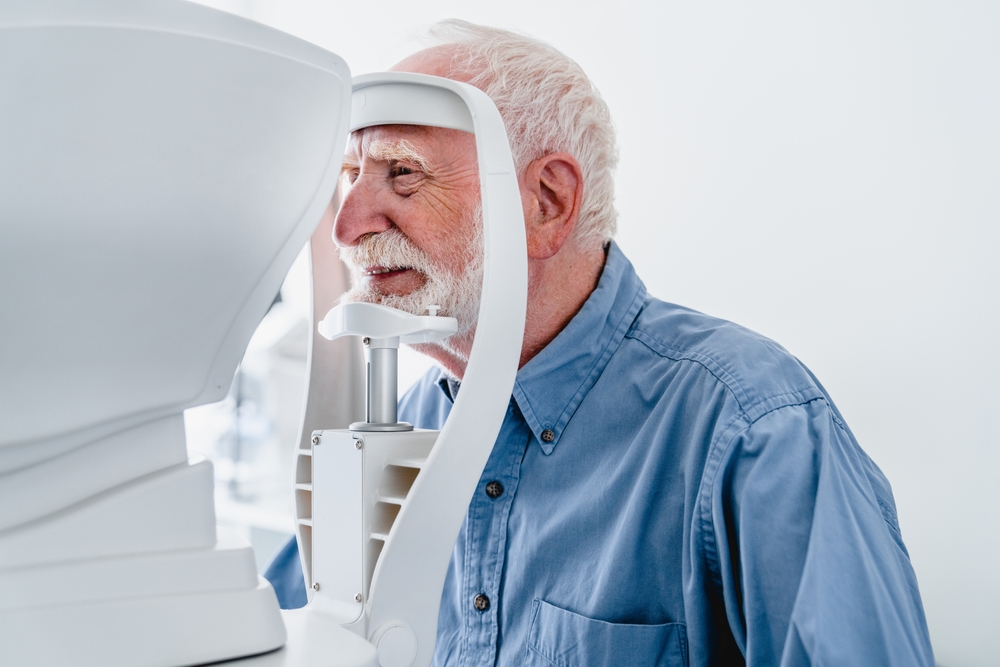Often called “the silent thief of sight,” glaucoma is the leading cause of vision loss in Americans over the age of sixty. Glaucoma has earned this nickname because it is often asymptomatic in its early stages, and people are not aware that they have it until their vision has already been negatively affected.
Keep reading to learn more about glaucoma, including what it is and how it’s treated!
What is Glaucoma?

Glaucoma is a group of eye diseases that can cause vision loss and blindness by damaging the optic nerve, which is essential for good vision. This damage is often caused by an abnormally high pressure in the eye.
In a healthy eye, a clear fluid called aqueous humor circulates inside the front portion of the eye. To maintain a constant healthy eye pressure, the eye continually produces a small amount of aqueous humor while an equal amount flows out of the eye through a microscopic drainage system.
If this drainage system becomes blocked or isn’t functioning properly, the fluid can’t flow out at its normal rate, and eye pressure increases. While it can occur at any age, it is more common in older adults.
Early detection through regular eye exams is key to protecting your vision from damage caused by glaucoma.
What Are The Different Types of Glaucoma?
Glaucoma is a group of eye diseases that can lead to vision loss and blindness if left untreated. There are several different types of glaucoma, each with their own characteristics and risk factors.
The main types of glaucoma are:
Open-Angle Glaucoma
Open-angle glaucoma is the most common form, accounting for the majority of all glaucoma cases. In this type, the drainage canals in the eye become gradually clogged over time, causing a slow increase in intraocular pressure (IOP).
This increased pressure can damage the optic nerve, leading to vision loss. Symptoms may not be noticeable until significant damage has occurred, which is why regular eye exams are crucial for early detection.
Angle-Closure Glaucoma
Also known as acute or narrow-angle glaucoma, angle-closure glaucoma occurs when the drainage angle between the iris and the cornea becomes blocked, causing a rapid increase in IOP. This type of glaucoma can occur suddenly and is considered a medical emergency.
Symptoms may include severe eye pain, headache, nausea, blurred vision, and halos around lights. Immediate treatment is necessary to prevent permanent vision loss.

Normal-Tension Glaucoma
Normal-tension glaucoma (NTG) is a form of open-angle glaucoma in which the optic nerve is damaged despite the IOP remaining within the normal range. The exact cause of NTG is unknown, but it may be related to reduced blood flow to the optic nerve or structural weaknesses in the nerve itself.
Secondary Glaucoma
Secondary glaucoma develops as a complication of another medical condition or injury. It can be open-angle or angle-closure in nature. Causes of secondary glaucoma include eye injuries, inflammation inside the eye (uveitis), advanced cataracts, diabetes, certain medications (such as corticosteroids), and tumors.
Congenital Glaucoma
Congenital glaucoma is a rare type of glaucoma that affects infants and young children. It occurs when the eye’s drainage system does not develop correctly before birth.
Symptoms may include a cloudy or enlarged cornea, excessive tearing, light sensitivity, and eyelid spasms. Children with a family history of congenital glaucoma or certain genetic disorders, such as Axenfeld-Rieger syndrome or Peters anomaly, may be at higher risk.
Pigmentary Glaucoma and Pseudoexfoliative Glaucoma are two additional types of open-angle glaucoma. Pigmentary glaucoma occurs when pigment from the iris clogs the drainage canals, while pseudoexfoliative glaucoma is caused by a buildup of abnormal protein fibers in the drainage canals.
Regular comprehensive eye exams are essential for the early detection and treatment of glaucoma.
Who is at Most Risk for Developing Glaucoma?
While eye doctors and researchers do not fully understand what causes open-angle and angle closure glaucoma, they have identified certain risk factors. A person may be at a higher risk of developing glaucoma if they:
Are Over the Age of 60

Aging affects the optic nerve, making it less tolerant of changes in eye pressure.
Have a Family History of Glaucoma
People who have a parent or sibling with glaucoma have an increased chance of developing the condition.
Are of African, Hispanic, or Asian descent
Certain ethnicities have higher rates of glaucoma.
Have Abnormally High Intraocular Pressure
Some people have high levels of intraocular pressure without any underlying cause.
How is Glaucoma Treated?
The damage caused by glaucoma is irreversible, so the main objectives of all glaucoma treatments are:
- The reduction of intraocular pressure.
- Minimization of further damage to the optic nerve.
- The prevention of vision loss.
Treatments for glaucoma include medication, surgery, and laser therapy.
Medication
Often, the first treatment a doctor will try is medicated eye drops or oral medications that either promote eye fluid drainage or decrease eye fluid production. In many cases, eye drops, oral medications, or a combination of the two can safely control intraocular pressure for many years.
Glaucoma Surgery
If a person’s glaucoma does not respond to medication,an eye doctor might recommend surgery. Surgical treatments for glaucoma include a trabeculectomy, which creates a new passageway for drainage of the aqueous humor, and aqueous shunt implantation, where ocular shunts (tiny valves) are implanted in the eye to increase drainage.
Laser Procedures
Laser therapies are some of the most advanced treatments for glaucoma. These therapies include laser trabeculoplasty, which improves the drainage of the aqueous humor; laser peripheral iridotomy, which creates a small hole in the iris to promote better drainage; and cyclophotocoagulation, which aims to reduce the production of aqueous humor.
While glaucoma can’t be prevented, the damage it causes can be minimized with early diagnosis and effective treatment. Scheduling regular comprehensive eye exams with a trusted eye care provider like Nevada Eye Physicians can protect your vision from the effects of glaucoma.
Do you want to have your eyes checked for glaucoma? Schedule an appointment at Nevada Eye Physicians in Las Vegas, NV, today!



